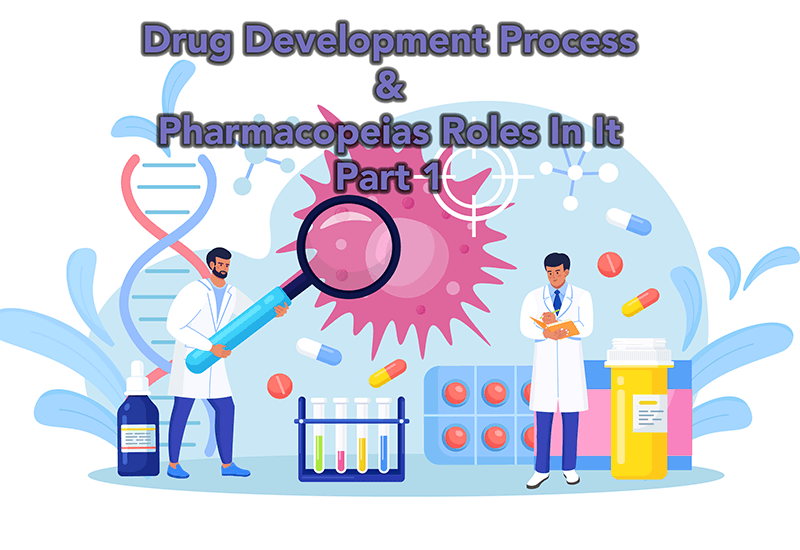The United States Pharmacopeia – National Formulary (USP-NF) serves as a resource for drug manufacturers, researchers, and anyone else involved in the development of pharmaceuticals with quality standards for ingredients and manufacturing processes. The USP-NF itself contains over 6,800 monographs for over-the-counter and prescription products, medical devices, supplements, and other related particles. It is revised and re-published yearly as online, in flash drives, and in print.
While there are over 20,000 prescription drugs approved by the FDA for marketing in the United States, the USP-NF covers the most pertinent and common ones. USP, as an organization, provides resources around the world to improve access to quality care and general best practices for quality ingredients.
When it comes to developing a new drug, the USP-NF can play an important role. There are four stages to drug development: R&D, regulatory review, manufacturing and distribution, and medication use. This article will cover the first two steps: research and development and regulatory review, as well as how the USP-NF impacts these stages.
Research and Development
Research and development: this is where the concept of a new drug is born and nurtured. At this point, the goal is to develop a medication that has low toxicity, high activity, and relatively few side effects. There has to be a balance between the benefit of using the drug and the risk that comes along with it. This risk – and, ultimately, approval – is determined through clinical trials.
Traditionally, R&D is conducted in its own subset of steps: a new compound is discovered, preclinical testing is done in a laboratory, and, finally, the sponsor submits an Investigational New Drug Application (IND) to the FDA. There are 3 phases during the IND process. Phase I uses healthy volunteers to test the drug’s actions, including metabolic and side effects. Phase II uses a small group of patients with the targeted affliction in very controlled environments to test the drug’s efficacy, as well as side effects. Often, if a drug is going to fail, it do so during Phase I or II.
When a drug makes it to Phase III, it has reached its most critical stage for FDA and other international regulatory agencies’ approval and labeling. Phase III trials use carefully selected patients in multiple areas to assess the drug’s overall benefit and risks. The relationship this phase truly defines helps regulators, guided by expert panels, to decide if the balance is favorable. This phase can take several years and typically involves up to 10,000 patients.
In extraordinary circumstances, the FDA may grant accelerated development of drugs – also known as fast tracking them. This program was put into place in 1992 after the push for more rapid development of HIV/AIDS treatment in the 1980s. While this phrase would most commonly be associated, now, with COVID-19 vaccines, it is also used frequently for oncology medications and other life-saving drugs.
How Do Pharmacopeias Impact R&D?
During the R&D phase, pharmacopeias, specifically the USP-NF, provide guidance on best practices for selecting high quality ingredients. By abiding by the standards and regulations around quality set forth in the USP-NF during the research and development phase, manufacturers can rest assured that their lives will be easier after FDA approval.
Regulatory Review
The FDA’s Center for Drug Evaluation and Research (CDER) is responsible for providing formal regulatory review and approval for all new prescription drugs, over-the-counter (OTC) drugs, and biologics. At this point, the FDA studies all available data to determine if the drug is safe and effective. In other words, its benefits need to outweigh its risks.
This is not a cut and dry process. It is customized to the intent of the drug and the population it serves. For example, oncology drugs treating life-threatening cancers that have limited treatment options might tolerate a higher risk than a drug for treating children’s fevers.
To start the process, the drug’s sponsors submit a New Drug Application (NDA) or Biologic Licensing Application (BLA), which should include all data they have collected. This includes information from both the preclinical and clinical studies on efficacy and safety, as well as their proposed labeling and manufacturing details. The FDA CDER’s Office Of New Drugs are responsible for reviewing these dossiers and communicating with the sponsor to address specific issues. Ultimately, the FDA collaborates with external experts for opinions on the decision making or regulatory issue.
A drug does not have to be the best possible option to receive FDA approval. There can be better alternatives in R&D or even already available on the market. All that the drug needs to do to be approved is prove efficacy (i.e. performs better than the placebo) and has benefits that outweigh the risks.
How Do Pharmacopeias Impact Regulatory Review?
The USP-NF is not a regulatory body but, according to their statements, they work “closely with government agencies, ministries, and regulatory authorities around the world to help provide standards of identity, strength, quality, and purity that can help safeguard the global supply of medicines, dietary supplements, and food ingredients.”
This means that they might not be directly involved in the regulatory review process, but they provide best standards written by volunteer experts who might very well also work with the FDA to determine approval. Not to mention, it is one of the best references for determining best practices when reviewing the manufacturing portion of the new drug’s proposal.
How Can You Learn More?
This is just the start of the drug development process, but we’ll soon cover the next steps. If you want to stay up to date and learn more, create a free account in our Knowledge Center.
We are clean air experts who are dedicated to spreading knowledge surrounding best practices for cleanrooms, PPE, and general cleanliness. We have compiled over 40 years of our expertise into the resources now available for free in our Knowledge Center.


